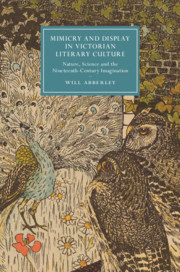 Mimicry and Display in Victorian Literary Culture
Mimicry and Display in Victorian Literary Culture Charles Kingsley, Hermeneutic Natural Theology and the Problem of Adaptive Appearance
Published online by Cambridge University Press: 16 May 2020
Chapter 2 examines how adaptive appearance could problematise Victorian natural theology through the example of the parson-naturalist Charles Kingsley. Kingsley’s faith was bound up with ideals of truth and sincerity, which he imagined as divine values that God’s creation exemplified and symbolised. Adaptive appearance challenged this textual view of nature, suggesting that nature’s aspects served purely to promote organisms’ survival, often through deceit. It is argued that Kingsley sometimes tried to resolve this contradiction by locating truthfulness in the rise of science instead of in raw, animal nature. In texts such as Glaucus: Wonders of the Shore and his evolutionary fairy tale The Water-Babies, he depicts science as a providential realisation of God’s values. However, Kingsley also sought to preserve vestiges of moral symbolism in nature since this notion underlay both his religious faith and the Church’s authority in knowledge of the natural world. Kingsley’s insistence on nature’s symbolism cohered with his insistence on the spirituality of the body, preserving a link between matter and divinity. This rhetorical strategy would be echoed by other religiously committed commentators who sought to reconcile adaptive appearance with the notion of nature as a divine text.
To save this book to your Kindle, first ensure [email protected] is added to your Approved Personal Document E-mail List under your Personal Document Settings on the Manage Your Content and Devices page of your Amazon account. Then enter the ‘name’ part of your Kindle email address below. Find out more about saving to your Kindle.
Note you can select to save to either the @free.kindle.com or @kindle.com variations. ‘@free.kindle.com’ emails are free but can only be saved to your device when it is connected to wi-fi. ‘@kindle.com’ emails can be delivered even when you are not connected to wi-fi, but note that service fees apply.
Find out more about the Kindle Personal Document Service.
To save content items to your account, please confirm that you agree to abide by our usage policies. If this is the first time you use this feature, you will be asked to authorise Cambridge Core to connect with your account. Find out more about saving content to Dropbox.
To save content items to your account, please confirm that you agree to abide by our usage policies. If this is the first time you use this feature, you will be asked to authorise Cambridge Core to connect with your account. Find out more about saving content to Google Drive.